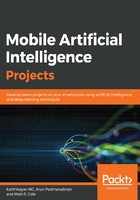
AI versus machine learning versus deep learning
AI is no new term given the plethora of articles we read online and the many movies based on it. So, before we proceed any further, let's take a step back and understand AI and the terms that regularly accompany it from a practitioner's point of view. We will get a clear distinction of what machine learning, deep learning, and AI are, as these terms are often used interchangeably:

AI is the capability that can be embedded into machines that allows machines to perform tasks that are characteristic of human intelligence. These tasks include seeing and recognizing objects, listening and distinguishing sounds, understanding and comprehending language, and other similar tasks.
Machine learning (ML) is a subset of AI that encompasses techniques used to make these human-like tasks possible. So, in a way, ML is what is used to achieve AI.
In essence, if we did not use ML to achieve these tasks, then we would actually be trying to write millions of lines of code with complex loops, rules, and decision trees.
ML gives machines the ability to learn without being explicitly programmed. So, instead of hardcoding rules for every possible scenario to a task, we simply provide examples of how the task is done versus how it should not be done. ML then trains the system on this provided data so it can learn for itself.
ML is an approach to AI where we can achieve tasks such as grouping or clustering, classifying, recommending, predicting, and forecasting data. Some common examples of this are classifying spam mail, stock market predictions, weather forecasting, and more.
Deep learning is a special technique in ML that emulates the human brain's biological structure and works to accomplish human-like tasks. This is done by building a network of neurons just like in the brain through an algorithmic approach using ANNs, which are stack of algorithms that can solve problems at human-like efficiency or better.
These layers are commonly referenced as deepnets (deep architectures) and each has a specific problem that it can be trained to solve. The deep learning space is currently at the cutting edge of what we see today, with applications such as autonomous driving, Alexa and Siri, machine vision, and more.
Throughout this book, we will be executing tasks and building apps that are built using these deepnets, and we will also solve use cases by building our very own deepnet architecture.